It’s been just over two weeks since my “Almost Here” post, and some of you might be wondering if something went wrong with the birth. Others might just chalk my radio silence up to the addition of newborn twins to an already bustling household. Both perspectives aren’t far off.
Let me just say up front that both girls are fine. We still have a visiting nurse coming to the house every few days to weigh Sydney and make sure they’re both continuing to develop, but despite their puniness (5lb 3oz for Ellie, 4lbs 8oz for Sydney), both girls are doing well. In fact, Ellie is thriving, and has been making strides since the moment she was born. Sydney, who arrived second, has had a bit bumpier road of it so far.
Two Wednesdays ago, the day Kris was scheduled to be induced, we arrived at the hospital to find that she was already dilated 4cm and nearly fully effaced, almost as if her body knew the plan. After five and a half hours of labor and only a handful pushes, Ellie came out first at 2:22pm in a remarkably drama-free birth. Except for the terrible back pain at the end that led Kris to get a last-minute epidural, you might even say it was an easy labor, if such a thing exists. After Ellie came out all pink and bellowing, I cut the cord and followed her over to the nurse’s station in the OR set up especially for her.
“Look at you, Ellie,” I cooed at her, happy tears brimming in my eyes as the nurses bustled about us. “Aren’t you our tough girl.”
“Are you the auntie?” one of the nurses asked me with a smile.
I blinked at her, nearly (but not quite) kicked out of the magic of meeting my daughter for the first time. “No,” I said, “I’m her other mother.” And then I looked back at Ellie, not caring what the response to this news might be.
After a brief check, a different nurse placed Ellie in my arms, and I carried her back to the operating table to meet Kris.
For a little while, Ellie lay on Kris’s chest while the doctors and nurses worked to figure out where Sydney was located. I was facing the monitors and could see that her heart rate was dropping and then rebounding every so often, but I wasn’t sure the numbers were correct. I knew from Alex’s birth that it’s difficult to monitor fetal heart rate externally, and our doctor and nurses had agreed more than once that the heart rate detected seemed to be Kris’s, not the baby’s.
But the concern in the room was palpable to everyone except Kris, who was busy gazing into Ellie’s eyes. Our doctor, Anna, who had grown up in the same thirty square mile corner of Southwest Michigan that I had, spoke in low tones to the other OB in the room. Then Ellie was bundled into a blanket and pressed into my arms so that Anna could do an ultrasound of Kris’s abdomen. The ultrasound revealed where Sydney was in utero, and Anna reached inside Kris and attached an electrode to the baby’s head to take an accurate reading of Sydney’s heart rate.
This time, we knew for certain that the numbers weren’t good. Baby heart rates should be between 120 and 160; Syd’s was in the low 70s.
“It’s okay,” I said to Kris, not because it was but because my job was to reassure her, to support her as she worked to safely deliver our girls into the world.
Anna and the other doctor conferred again, and then she said, “Kris, I’d like to use an obstetric vacuum, which I’ll attach to the baby’s head. We’ll work together—when you push, I’ll pull. You’ll be doing most of the work. I’ll just be assisting you.”
“Are there any risks?” I asked, flashing on a Grey’s Anatomy episode where one of the residents had joked about pulling a baby’s head off with a similar device. (At least, I think it was a joke.)
Before Anna could respond, the other doctor, a sixty-something man with white hair and a condescending air, said to me, “I think you should listen to your doctor and do as she advises.”
“I only asked a question,” I returned. We’d never met this doctor before now, nor had we agreed to his presence at the birth. He was a “hospitalist” and was only in the room because our local facility requires two OBs at any twin birth. “I think it’s only normal to ask about potential complications.”
“Again, you should do as your doctor advises,” he intoned in his deep, paternal voice. “Your other option is to have an emergency C section.”
I nearly rolled my eyes at his invocation of the “C” word. Alex had been born at the same hospital, and we’d endured bullying of a similar nature. But instead I stared at him and said as scathingly as I could while cradling a gorgeous, minutes-old newborn against my chest, “I’m fairly certain my doctor can speak for herself.”
At this, Kris gave me an entreating look, something else I’m familiar with after being married to a conflict-averse Scandinavian Minnesotan for eight years, and I might actually have rolled my eyes then. But I turned my back on the interloper doctor and ignored him, for the sake of my laboring wife. There was only so much she should have to put up with, and I would no doubt have other, better-timed opportunities in the future to wrangle with patronizing medical personnel.
The vacuum was brought forth, Kris pushed and Anna pulled, and soon the baby’s heart rate rebounded. But the mood was still tense as Anna kept driving Kris to push, not letting her take much of a break. Fortunately, my wife has crazy strength (even Dr. Jackass had noted this fact earlier), and after half a dozen pushes, Anna detached the vacuum and pulled Sydney out into the world.
Before I continue, I have to share a dream I had less than a month before the babies arrived. It’s still nearly as vivid now as it was the morning I awoke sweating and relieved to return to a reality where Kris was still pregnant. Here’s the quick synopsis: Kris and I are at the hospital, and she’s having a C section. For some reason, I’m on the doctor’s side of the curtain, not at Kris’s head, and I’m worried that I’m going to faint at the sight of blood as I nearly did when Alex was born.
 But my Grey’s Anatomy residency, as I refer to my recent push to watch seven seasons of the Seattle-based medical drama in six weeks, has prepared me well for the sight of surgical gore. I watch intently as the doctor opens the uterus to reveal our babies, each in a separate section of Kris’s abdomen. Unfortunately, my relief at not fainting quickly gives way to despair as I realize that one of the babies isn’t breathing.
But my Grey’s Anatomy residency, as I refer to my recent push to watch seven seasons of the Seattle-based medical drama in six weeks, has prepared me well for the sight of surgical gore. I watch intently as the doctor opens the uterus to reveal our babies, each in a separate section of Kris’s abdomen. Unfortunately, my relief at not fainting quickly gives way to despair as I realize that one of the babies isn’t breathing.
I shared this dream with a few people before the birth, including my sister-in-law, G. And, well, Kris, too. I mean, she’s my best friend and the mother of my children, after all. But even I, an often filterless Scotch-Irish firebrand, knew I couldn’t tell her that one of the babies appeared not to be alive. I only mentioned that one “wasn’t doing so well” and that both babies had full heads of dark hair. We shook our heads at that one—Alex was bald for the first year and a half of her life. We assumed the same would be true for the twins, too.
Fortunately, Kris doesn’t worry about things she can’t see, touch, or reason with, which means she doesn’t believe in psychic phenomena. Especially not phenomena related to my ability to predict the future. That left only one of us (two of us, G?) slightly freaked out by my dream.
Fast forward a few weeks to the delivery, and imagine the creeping horror I felt as I watched Sydney emerge in a final push into Anna’s arms—not clenched and pissed off like her older by twenty-three minutes sister, but white and completely limp, all four tiny limbs hanging down toward the floor. Just like in my dream, one of our babies wasn’t breathing.
Anna’s concern didn’t appear to match mine. She clamped off the umbilical cord and ordered me to cut it in a firm tone tinged only slightly with urgency.
“What, me??” my mind screamed. But I took the scissors and snipped through the pale, wiry cord just as I had done for Ellie, even as a very different sort of tears filled my eyes and tightened my throat.
Kris hadn’t been able to see Sydney come out, but she could see her now. As Anna handed the limp, unmoving baby to a waiting nurse, Kris and I exchanged a horrified look. Then I remembered my role.
“It’ll be okay,” I said. “I think I heard her cry.”
“You did?” Kris asked anxiously.
“I think so,” I said. And it was true. I thought I’d heard the feeblest infant cry I could ever have imagined emerge from Sydney’s corner of the room. At least, I hoped I had.
“I’ll go be with her,” I added, handing Ellie to the nearest unencumbered nurse.
“Yes,” Kris said, tears in her eyes. “Go be with her.”
Two years ago when Alex finally emerged after 35 long, dramatic hours, the OB explained that Kris had retained her placenta, and that she would have to be taken to an OR to have it removed. Looking back, I’m pretty sure the OB meant they needed a sterile setting for the procedure, but at the time, after so many sleepless hours and the stress of being transferred from our birth center to the hospital and threatened with a C section numerous times, Kris and I both reacted as if she were being wheeled off to a surgery from which she might not return. We still joke about the moment when we looked at each other across the OB’s shoulder and Kris said, “Don’t leave the baby,” and I promised, “I never will.”
This time around, with Sydney, Kris and I had an equal or greater amount of fear in our hearts. I don’t think that moment will ever be something we joke about, though.
I don’t remember taking the handful of steps to Sydney’s OR table, only the image of three nurses working on her pale, unmoving form, feeding oxygen to her through a tiny mask. But even as I watched, her body pinked up rapidly and she began to squirm on the table. She was so little, only 4.5 pounds we found out later, with long skinny limbs and a bony frame. She looked so helpless, lying there with three figures in scrubs bent over her attaching electrodes and other monitors to her slowly reddening form.
But she was moving, and breathing, too, and I started to believe that it was her feeble little cry I had heard as they whisked her away to be worked on. That had to mean something, didn’t it?
“How is she?” I asked Cris, a nurse who had helped out during my Kris’s few hours of labor and was now gently massaging Sydney’s chest.
“She’s doing fine,” Cris said. “Her lung sounds are strong, her heart rate is good, and we only had to help her breathe for a minute or two.”
This was not at all what I’d expected to hear.
“But she was so white,” I blurted. “And she wasn’t breathing.”
“No, she was pink the whole time,” the nurse told me. “This often happens to Baby B. They frequently become stressed right after Baby A is delivered, but I’m not worried in this case. She’s doing really well.”
“She is?”
“Yes,” she said gently, “she is.”
“Thank you for telling me that,” I said, and wrapped my arm around the nurse’s shoulder in a half-hug. “You have no idea how much that means. Thank you so much.”
As a precaution, the medical staff decided to take Sydney to the nursery to monitor her vitals—pulse ox, temperature, heart rate, neurological response—closely for two hours after the birth. If all went well, which the nurse assured me she believed it would, then Sydney would be released to us in our recovery room, where the monitoring would continue through the next twenty-four hours. Just to be safe.
“You can be with her in the nursery the whole time she’s there,” a different nurse told me.
I looked at him. Of course I would be with her—with the last minute epidural, Kris was confined to her hospital bed, and there was no way she could be at Sydney’s bedside. Frankly, it never occurred to either of us that I wouldn’t be.
In the nursery, Sydney was the only patient. This meant that the pediatrician and both nurses on duty could devote all of their attention to her. They confirmed that while upsetting, Sydney’s stress at birth was not particularly troubling, given her immediate recovery. It turned out that her vitals were strong, except for her temperature and sucrose levels, neither of which was surprising or worrisome given her size and state at birth. For those who know about such things, Sydney’s 5-minute APGAR scores were normal. These, rather than her less impressive 1-minute scores, are what “count,” according to the nurses and doctor. Baby Sydney, our little fighter, should be just fine.
Later, after the doctor had okayed Sydney’s release from the nursery and Kris was able to hold Syd in her arms for the very first time, we talked about the way the nurse had assured me I could be in the nursery with our daughter. He had said it in a way that made us both think my being there might be questioned. Was this because I was the other mother, or was any parent’s presence in the nursery potentially suspect? One of those things we won’t ever know, I suppose. But we did wonder, and not only because of the nurse’s seemingly overly-conciliatory tone.
In Confessions of the Other Mother, Hillary Goodridge, one of the plaintiffs in the 2004 Massachusetts Supreme Court case that made it possible for Kris and me to legally wed a year later, writes about her experience as a non-biological mother at her daughter Annie’s birth. When her partner’s planned C-section met with unexpected complications, Goodridge went with the baby to the Neonatal Intensive Care Unit, where the doctors and nurses worked to clear a blockage from Annie’s airway. Once Annie was finally stable, Goodridge left the NICU, intending to find her partner and update her on their daughter’s condition.
But in 1990s-era Massachusetts, same-sex partners had next to no medical visitation rights. When Goodridge tried to visit her wife, she was not allowed into the maternity ward because she was not a bonafide relative by hospital definition. When she tried to return to the NICU to be with their daughter, she was not allowed to see the baby because she was not “related” to her child, according to hospital policy. This travesty was the main reason the Goodridges cited when they sued the Commonwealth of Massachusetts for the right to legally marry.
In my own case, when Sydney was carted away to be monitored, I didn’t think about Goodridge’s essay, which I had read and discussed with Kris well in advance of Alex’s birth two years earlier. I didn’t think of the possibility of being prevented from seeing my wife or either of my daughters. I was so focused on this tiny, naked creature covered in electrodes, the baby I had witnessed swimming in Kris’s belly all these many weeks. She was Sydney, our little acrobat, our Baby B. She was my daughter, and she had to be okay because I couldn’t imagine having to tell Kris or Alex or anyone else that she wasn’t.
Fortunately, Sydney was okay. And two weeks later, she’s still okay, if not completely thriving. She has had jaundice, thrush, and difficulty feeding, all of which has led to multiple home care visits from the Walgreen’s visiting nurse service. Ellie has had her share of challenges, too, mainly in the form of colic. But both have rebounded to their birth weight and beyond by now, and in the last couple of days, we haven’t had to pester Sydney to get her to eat. Now she’s polishing off her bottle without a single poke in the ribs or squeeze of the toes (methods highly touted by our visiting nurses). In fact, she’s sitting on my lap as I write this, eyes open, fully alert, listening to Justin Roberts sing about great big suns.
Almost inadvertently, then, it seems I’m writing my delayed Prop 8/ DOMA Supreme Court response after all. So much was made in those proceedings, particularly the Prop 8 hearings, about the children of same-sex couples. As Justice Kennedy pointed out, the children of same-sex parents want their families “to have full recognition and status.” But I would argue that more than merely “wanting” us to be recognized as a family under the law, our children need the status and protections legal recognition provides. Sydney and Ellie’s birth story demonstrates what happens to those of us who live in a state that grants us full parental and marriage rights. But what if our story had been set in Alabama? Nebraska? Michigan, even?
We are neither the “they” nor the “them” continuously referred to in the Supreme Court hearings. We are Kate and Kris, or Mama and Mimi, depending on whom you ask. We are each someone’s daughter, sister, niece, cousin, friend. We are our children’s mothers. And we are tax-paying, home-owning, gainfully employed American citizens.
So I’ll say it again: Kris, Alex, Ellie, Sydney, and I are not a social experiment. We are an American family. A family of five, as it turns out.
A few weeks ago, one of my Smith friends saw a post on Facebook about our expanding family and wrote, “TWINS??” I replied that our soon-to-be family of five wasn’t something I would ever have foreseen back in our college days.
“Who could foresee that?” she replied. “But it looks like a pretty nice life you have out there.”
And it is. No matter what the Supreme Court rules, Kris and I know that we are a family. Fortunately, so does the state we call home.
Thus begins our Life of Five, as my sister-in-law G recently wrote in a Facebook post. (Props as usual, G.) I’ll probably have even less time now to update the blog, of course, but I will give it a whirl in between late-night bottle feedings and continual diaper changes—who knew how much human waste three children under the age of two and a half could produce? Geez.
So they’re here, and they’re growing, and someday too soon I’ll awaken to realize that my babies, like Alex, aren’t babies anymore. But for now, Ellie and Sydney are these amazing-brand-new-tiny-human-beings who need their parents to rock them to sleep and sing their songs, the same songs they’ll someday learn to sing for themselves out in the world beyond the narrow confines of our little house in the woods.
Someday. But not yet. Not just yet.

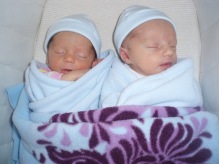


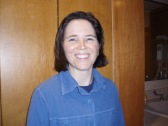
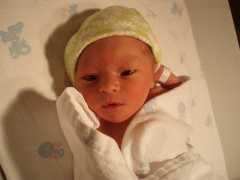
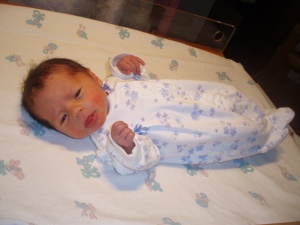

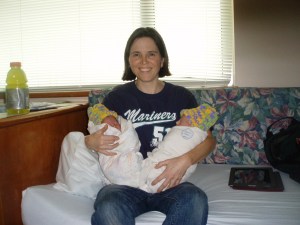
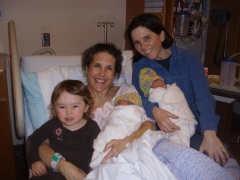
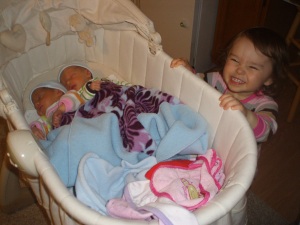















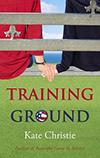







Kate, so lovely you found the time, to blog us the birth story. I wish you would leave it, to your books, to drive me to tears. But the tears I shed, reading about Sydney’s difficulties, would be hard to replicate. I am thankful you are all okay and thriving. Thanks for finding the time, to blog.
Thank you for updating us. Wonderful blog and beautiful family. Life of Five. Love it.
I am so delighted that you are one healthy family of five! Thank you for sharing a small slice of what you and Kris have gone through to get where you are today. You both do have a pretty good life!
Beautifully written and touching. Not to take away your rightful mistrust of people who may not give you the rights and authority you deserve…but my hospital too made a big deal of telling us that yes, we could in fact be in the nursery at any time our baby is in there….let’s hope THAT was the case, a reassurance to any parent and not that they thought they were giving you special reassurance because you were her other mom. You are such a beautiful family!!! xoxo
Kate, I wish you and Kris nothing but immense joy and happiness with your beautiful daughters. I am so happy for you both that everything turned out well. Enjoy every minute!
A beautiful family of five. Thanks so much for sharing your experience. I had watery eyes reading about Sydney’s struggles and chills while reading about being an American family. All your girls are adorable and I wish you and Kris all the best!